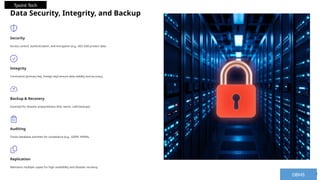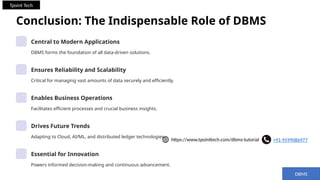Introduction-to-Database-Management-Systems-DBMS.pptx
- 1. Introduction to Database Management Systems (DBMS) Welcome to our deep dive into Database Management Systems (DBMS). In an increasingly data-driven world, understanding how data is managed is crucial. DBMS are the backbone of modern applications, enabling efficient storage, retrieval, and manipulation of structured data. They ensure data integrity and security, forming the core of over 95% of enterprise applications in a market valued at $76 billion in 2023. DBMS +91-9599086977 https://www.tpointtech.com/dbms-tutorial Tpoint Tech
- 2. Core Concepts of DBMS Data Model Organizes data logically, like relational or object-oriented models. Schema Defines the database structure, including tables, fields, and relationships. Instance The actual data stored in the database at any given moment. Data Independence Ensures physical or logical changes don't impact applications. Database Users Diverse roles, from administrators managing systems to end-users. DBMS Tpoint Tech
- 3. Types of DBMS Models Relational DBMS (RDBMS) Most common, uses tables and SQL (e.g., MySQL, PostgreSQL, Oracle). NoSQL DBMS Flexible schemas, highly scalable for big data (e.g., MongoDB, Cassandra, Redis). Hierarchical DBMS Tree-like structure, often found in legacy systems. Network DBMS Graph-like structure, offering more flexibility than hierarchical models. Object-Oriented DBMS Stores objects directly, less common in modern applications. DBMS Tpoint Tech
- 4. Database Design Principles ER Model Visualizes entities, attributes, and relationships for clear design. Normalization Reduces data redundancy and enhances data integrity (1NF, 2NF, 3NF, BCNF). Denormalization Optimizes read performance for specific application needs. Indexing Accelerates data retrieval operations, improving query speed by 10-100x. Data Dictionary A centralized repository defining metadata for all database elements. DBMS Tpoint Tech
- 5. SQL: The Standard Database Language SQL, or Structured Query Language, is the universal language for managing and manipulating relational databases. It's standardized by ISO/ANSI (SQL-92, SQL:2023) and is divided into several sub-languages, each serving a specific purpose: DDL (Data Definition Language) CREATE, ALTER, DROP tables/schemas. DML (Data Manipulation Language) SELECT, INSERT, UPDATE, DELETE data. DCL (Data Control Language) GRANT, REVOKE permissions. TCL (Transaction Control Language) COMMIT, ROLLBACK transactions. DBMS Tpoint Tech
- 6. Transaction Management & Concurrency Control 1 Transactions Logical units of work, designed to be atomic operations. 2 ACID Properties Guarantee Atomicity, Consistency, Isolation, and Durability in transactions. 3 Concurrency Control Manages simultaneous access by multiple users to prevent conflicts. 4 Locking Mechanisms (e.g., shared, exclusive locks) to prevent data inconsistencies. 5 Deadlock A state where transactions endlessly wait for resources held by each other. DBMS Tpoint Tech
- 7. Data Security, Integrity, and Backup Security Access control, authentication, and encryption (e.g., AES-256) protect data. Integrity Constraints (primary key, foreign key) ensure data validity and accuracy. Backup & Recovery Essential for disaster preparedness (hot, warm, cold backups). Auditing Tracks database activities for compliance (e.g., GDPR, HIPAA). Replication Maintains multiple copies for high availability and disaster recovery. DBMS Tpoint Tech
- 8. Conclusion: The Indispensable Role of DBMS Central to Modern Applications DBMS forms the foundation of all data-driven solutions. Ensures Reliability and Scalability Critical for managing vast amounts of data securely and efficiently. Enables Business Operations Facilitates efficient processes and crucial business insights. Drives Future Trends Adapting to Cloud, AI/ML, and distributed ledger technologies. Essential for Innovation Powers informed decision-making and continuous advancement. DBMS +91-9599086977 https://www.tpointtech.com/dbms-tutorial Tpoint Tech







